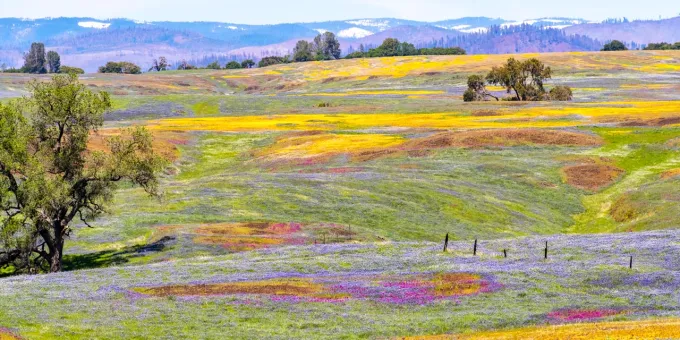Rumors are flying: California may see a superbloom in the next few weeks, or at least a phantasmagoric flush of flowers. As of late February, colorful blossoms are putting on a show in eastern San Diego County and the Inland Empire lowlands, prompting botanists and state officials to be cautiously optimistic about a better-than-average wildflower bloom.
The Golden State’s spring flower show is always beautiful, but the colloquial term “superbloom” refers to a high-octane version of the annual display. These rare and often unpredictable occurrences typically happen about once a decade, most recently in 2019.
What makes the magic happen? Superblooms occur when rain falls in frequent intervals between October and February—especially when that rain follows a long period of drought. This leads to widespread germination of wildflower seeds that may have lain dormant for years.
Whether or not this spring achieves superbloom status, right now an extraordinary number of flowers are brightening roadsides and trails in warm inland regions, including Anza-Borrego Desert State Park east of San Diego and Chino Hills State Park south of Ontario.
Bloom Timing and Updates
Keep in mind that the beauty doesn’t happen all at once. The timing of the bloom generally rises with elevation, so the deserts bloom first, followed by the lowland foothills and coast. High-elevation mountain regions don’t show their flower power until long after snowmelt, typically mid-July.
Additionally, minor weather shifts have a big impact on wildflowers, making peak bloom periods hard to predict. Before you set out on a flower safari, use the internet as your guide—many parks and preserves offer updates on wildflower status on their websites and social media pages. Visit the California State Parks’ Wildflower Bloom Web Page, which is devoted to what’s blooming where in state parks. Another great resource is the Theodore Payne Foundation Wildflower Hotline, which offers recorded reports on Southern and Central California’s best viewing sites. The hotline goes live on March 3 and is updated every Friday from March through May (phone 818-768-1802 ext. 7).
Best Places to See California Wildflowers
For the next several weeks, you’ll find flowers blooming in deserts, low-elevation grasslands, and table-mountain landscapes including these hotspots:
Anza-Borrego Desert State Park, Borrego Springs: Wildflowers are currently showing their colors on alluvial fans and in washes. Sand verbena, desert lily, dune evening primrose, and desert sunflowers are blooming with enthusiasm at Coyote Canyon/DiGiorgio Road, Henderson Canyon Road, and June Wash. Check for bloom updates on Facebook and Instagram.
Chino Hills State Park, Chino Hills: Hike the Bane Ridge Trail or drive Bane Road to see California poppies, arroyo lupine, and canterbury bells. Check for bloom updates on Facebook and Instagram.
Antelope Valley California Poppy Reserve, Lancaster: Poppy plants have pushed up from the earth, and a few poppies are starting to bloom. Park staff expect a better-than-average bloom will begin in March. Call the Poppy Reserve Wildflower Hotline at 661-724-1180 for updates or view the park’s live webcam.
San Luis Obispo County: On California’s Central Coast, an easy drive along wildflower-rich Shell Creek Road in Santa Margarita delivers an eye-popping display of orange poppies and sky-blue lupine. In Los Osos, Montaña de Oro State Park lives up to its name (“mountains of gold”) with bluffs covered in California poppies. Sixty miles east, the grasslands of Carrizo Plain National Monument are showing off goldfields, tidy tips, owl’s clover, and hillside daisies.
North Table Mountain Ecological Reserve, Oroville: Flowers should start showing themselves on this elevated basalt mesa around the first week of March. Formed by ancient lava flows, Table Mountain stores rainwater in its porous rock, which results in blankets of flowers, fascinating vernal pools, and ephemeral waterfalls.
Jepson Prairie Preserve, Dixon: From March to May, thousands of tiny wildflowers paint the landscape in ribbons of yellow, purple, and white in one of California’s few remaining native bunchgrass prairies. More than 400 species of plants thrive here, along with vernal pools filled with fairy shrimp and other rare invertebrates.
Russian Ridge Preserve, Redwood City: Flower lovers flock to this ridgetop paradise to see orange poppies and blue lupine painting the grasslands like a Monet masterpiece. When these beauties fade, they’re replaced by mule’s ears, brodiaea, and farewell-to-spring, so you can usually find blossoms well into May.
Tips for Responsible Wildflower Viewing
As you head out to view these colorful floral treasures, help preserve their fragile beauty by following these simple guidelines:
- Take only photographs, not flowers.
- Take photographs OF flowers, not IN flowers: Keep your feet on designated trails and paths. Stepping on flowers (or posing, sitting, or picnicking among them) damages existing blooms and prevents the next generation from growing. Trampled flowers can’t reseed themselves for next year.
- Many wildflower locations are in desert and rural areas with no cell service and limited services, so download maps and information before you arrive, and pack your car with water and snacks.
